Here we go again. Years ago, I wrote a column for Publisher Paul (at one of his previous enterprises), concerning the gems to be found in the world’s least read book of useful information: a new car or truck Owner Manual.
This time my particular candidate is the exceptional Owner Manual for the 2012 VW Passat, the new Chattanooga product that has made the cut as one of three finalists for North American Car of the Year. (The others are the Ford Focus and the Hyundai Elantra.)
For me, the Passat—albeit the first VW I have encountered since a retro look at a Beetle some years ago—is pure Vanilla. Driving it for a week doesn’t leave an impression either favorable or unfavorable. It meets all the driver’s needs and pleasures for a solid family five-passenger sedan (except for the $34,000 sticker price including all the standard upscale goodies), plus it has exceptional rear seat legroom and trunk space. There’s nothing at all wrong with Vanilla—Passat should be a conservative buy for those who otherwise likely would lean Camry- or Accord- or Malibu-wise.
(For TheDetroitBureau.com’s original review of the 2012 Volkswagen Passat, Click Here.)
What’s exceptional about the 2012 Passat is its Owner Manual (OM), perhaps the best I’ve ever seen. Yep, really. You can talk performance, roominess, handling…but the Passat’s Owner’s Manual really makes a difference.
It is filled with tri-color illustrations of all the necessary things you need to know about operating an otherwise strange set of controls and instruments–including a global chart for adjustment of magnetic variations of the on-board compass. I plucked the OM from the glove box for a look-see about some of the Passat’s instrumentation.
The Passat OM bonus comes in the very complete explanations of fundamental safety devices. Perhaps other VW OMs are the same and always have been, but I find it hard to associate this with the fundamentalist Beetles that, when first imported in the late 1950s, didn’t even have fuel gauges, much less any creature comforts.
(As I recall, you drove a Beetle until it coughed, then threw a little switch under the dash for access to a one-gallon emergency tank.)
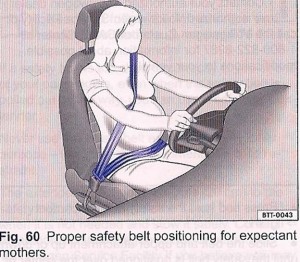 Among the many safety instructions are illustrations showing how an expectant mother should wear her three-point safety belt and another demonstrating how an unbelted rear passenger can injure a properly belted front passenger in a frontal impact. Other colored drawings show the protection range of the driver, passenger, side and curtain air bags.
Among the many safety instructions are illustrations showing how an expectant mother should wear her three-point safety belt and another demonstrating how an unbelted rear passenger can injure a properly belted front passenger in a frontal impact. Other colored drawings show the protection range of the driver, passenger, side and curtain air bags.
These are also plusses, not to be found so well explained and illustrated in, for instance, the OMs of my family Ford product. Nor did I note them in the Chevrolet, Fiat/Chrysler, and Honda Owner Manuals in new cars I’ve experienced in recent weeks.
Passat’s OM also has a couple of pages of tips about stretching the car’s fuel consumption, but that is nothing new. Some of the oldest OMs I’ve examined, for instance one for a 1910 Buick, include instructions for conserving fuel.
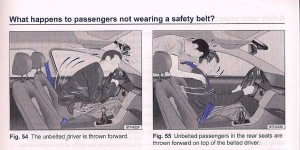 Another interesting section of the Passat OM is directed to owners of diesel-engine cars. Under the latest Federal Clean Air regulations, diesels are compelled to provide minimization of emissions for diesel fuel, one solution to which is re-charging the diesel vehicle’s exhaust-filtering catalytic converter. So the Passat OM details both how to handle the re-charging and illustrates the procedure, again with crystal clear drawings.
Another interesting section of the Passat OM is directed to owners of diesel-engine cars. Under the latest Federal Clean Air regulations, diesels are compelled to provide minimization of emissions for diesel fuel, one solution to which is re-charging the diesel vehicle’s exhaust-filtering catalytic converter. So the Passat OM details both how to handle the re-charging and illustrates the procedure, again with crystal clear drawings.
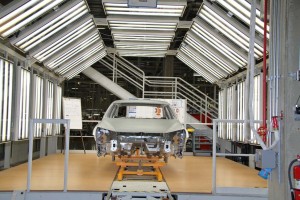
Aiming to overcome past quality problems, VW's new plant focuses heavily on inspection stations, like this one, to reveal any manufacturing issue.
One downer I found in the otherwise sparkling Passat OM was what is had to say about Black Boxes, AKA Electronic Data Recorders or EDRs. Because I am a big believer in these automotive lie detectors (“I was only going 20,” or “Of course I had my seat belt fastened”), I quote the Passat passage below:
Your vehicle is not equipped with an Event Data Recorder (EDR).
EDRs, sometimes called “crash recorders,” are installed by some manufacturers for the express purpose of capturing data for retrieval after an accident or crash event.
Some state laws restrict the retrieval or downloading of data stores by EDRs installed in a vehicle after an accident or crash event without the owner’s consent.
Although your vehicle is not equipped with an EDR, it is equipped with a number of electronic control modules for various vehicle systems, such as engine management, emission control, airbags and safety belts.
These electronic control modules also record data during normal vehicle operation for diagnostic and repair purposes. Their recording capability is limited to data (no sound is recorded). Only a small amount of data is actually recorded over a very limited period of time, or stored when a system fault is detected by a control module. Some of the data stored may relate to vehicle speed, direction, or braking, as well as restraint system use and performance in the event of a crash. Stored data can only be read and downloaded with special equipment.
In contrast to the VW approach to EDRs, here is an excerpt from the 2011 Ford Escape Owner Manual:
This vehicle is equipped with an event data recorder (EDR). The main purpose of an EDR is to record, in certain crash or near crash-like situations, such as an airbag deployment or hitting a road obstacle; This data will assist in understanding how a vehicle’s systems performed. The EDR is designed to record data related to vehicle dynamics and safety systems for a short period of time, typically 30 seconds or less. The EDR is designed to record such data as:
• How various systems in your vehicle were operating;
• Whether or not the driver and passenger seatbelts were buckled/fastened;
• How far (if at all) the driver was depressing the accelerator and/or the brake pedal; and
• How fast the vehicle was traveling; and
•Where the driver was positioning the steering wheel.
Now, it seems to me that VW is talking out of both sides of its mouth. It says the car doesn’t have an EDR, then proceeds to enumerate all the vehicle crash instant readouts that it does have—just like the vehicles of General Motors, Ford and other forthright auto manufacturers. So why is VW so coy about its readouts? Results of installing these recorders have enormously improved research on actual circumstances of highway crashes, and avoidance of much unmerited litigation. Indeed, I recently heard of a case where EDR readouts led to a quick out-of-court settlement, with appropriate monetary recovery for a badly injured, innocent-of-fault motorist.
Except for this glitch, I would say the Passat should win the 2012 NAIAS COTY award, if for no other reason than its stellar Owner Manual.

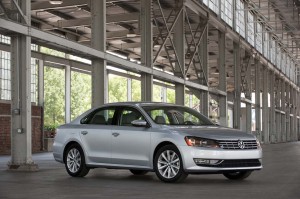
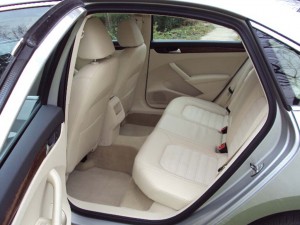
The Passat is $34,000? And assembled in Chattanooga by some of the lowest-compensated autoworkers in the United States? That owner’s manual sure is expensive, and VW is making quite a profit off of it. Senator Bob must be proud, having that plant in his backyard and all. His vision of manufacturing in America for sure. I’ll bet the German metalworker’s union finds this little tidbit more than interesting.